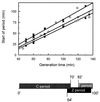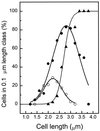Timing of FtsZ assembly in Escherichia coli
- PMID: 10464184
- PMCID: PMC94019
- DOI: 10.1128/JB.181.17.5167-5175.1999
Timing of FtsZ assembly in Escherichia coli
Abstract
The timing of the appearance of the FtsZ ring at the future site of division in Escherichia coli was determined by in situ immunofluorescence microscopy for two strains grown under steady-state conditions. The strains, B/rA and K-12 MC4100, differ largely in the duration of the D period, the time between termination of DNA replication and cell division. In both strains and under various growth conditions, the assembly of the FtsZ ring was initiated approximately simultaneously with the start of the D period. This is well before nucleoid separation or initiation of constriction as determined by fluorescence and phase-contrast microscopy. The durations of the Z-ring period, the D period, and the period with a visible constriction seem to be correlated under all investigated growth conditions in these strains. These results suggest that (near) termination of DNA replication could provide a signal that initiates the process of cell division.
Figures








References
-
- Addinal S G, Cao C, Lutkenhaus J. FtsN, a late recruit to the septum in Escherichia coli. Mol Microbiol. 1997;25:303–309. - PubMed
-
- Addinal S G, Cao C, Lutkenhaus J. Temperature shift experiments with an ftsZ84(Ts) strain reveal rapid dynamics of FtsZ localization and indicate that the Z ring is required throughout septation and cannot reoccupy division sites once constriction has initiated. J Bacteriol. 1997;179:4277–4284. - PMC - PubMed
-
- Bi E, Lutkenhaus J. FtsZ ring structure associated with division in Escherichia coli. Nature. 1991;354:161–164. - PubMed
Publication types
MeSH terms
Substances
LinkOut - more resources
Full Text Sources
Other Literature Sources
Molecular Biology Databases

